All Fotos Copyright Jonathan Alpeyrie
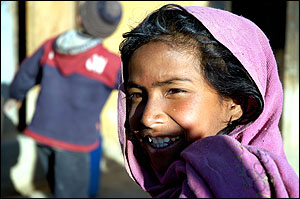
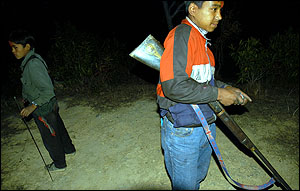
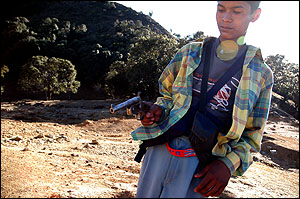
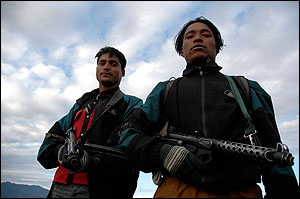
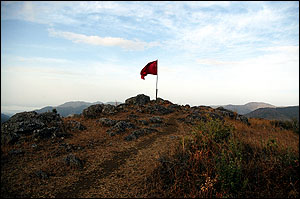
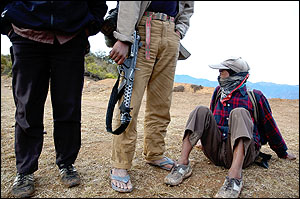
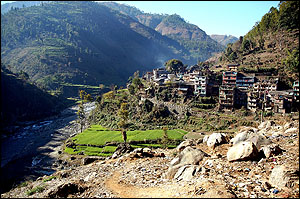
|
Maoist rebellion
Article by Jonathan Alpeyrie
February 2005
On a rock in the middle of the remote region of Rolpa district in Western Nepal, is written with white paint a Maoist saying: “To rebel is a people’s right”. This sentence alone defines the nature of the Maoist rebellion, a fight which has been raging for ten years now. Since February 13 1996, the Royal Nepalese government has been interlocked in fighting against a foe who finds its strength not in its allies but rather in its ability to adapt to new situations, and a devout and politicize core of fighters and local sympathizers. The Maoists have been able to rise from a small and local rebellion to a national threat for the Royal government. They operate in most of the countryside, in 68 of the 75 national districts, ambushing, influencing locals and killing army soldiers and policemen. Their progress in military and political affairs has been a very gradual but constant in part due to a thorough and patient manipulation of the population. However, in order to fully understand the rise of violence in a country known for its peaceful past, we need to explain its past.
The rise of the Maoist movement is not a new phenomenon in Nepal; it finds its roots in the early political trends of India in the late 40’s, where communism was becoming significant. In February 1959, the Nepalese elects the first democratic parliament, with at his head the Prime Minister Koirala. He took the necessary steps to lead his country towards a more modern and competitive entity: education became free, and an embryonic welfare system was put in place. Nepal was becoming a stable and prosperous country.
Unfortunately laws rarely change mentalities. Nepal is a country riddled with an ancient social apparatus, which defines very clearly social status between for instance the rich Brahman, and the poor Dalit cast. Each cast has a specific place in Nepali society, negating any social change or opportunities for the poorest. The rich classes, often landowners, saw Koirala’s reforms as a threat to their wealth of political power, and convinced the king Mahendra to dissolve the new government. On December 15 1962, the king did exactly that, and retained full power for himself. Nepal was once more a dictatorship. A few days later he proclaimed the creation of the “system Panchayat”, a supposedly democratic dictatorship, which does no allow for any creation of new political parties within the government. It is then that the Maoist movement took shape to balance the political power in Nepal.
The Nepali Maoists took their influence from their Indian Kin, who where themselves heavily influenced by the Leninist/Marxist movements of the 1920’s. Between 1962 and 1990, a quiet revolution took shape in Western Nepal, organizing their political branch, refining their propaganda skills directed towards the local population. By early 1990 the Maoists leaders were ready to expand their political and military agenda. On January 15th 1990, the political branch reunited to create the CPN. In November 1994, with the parliamentary elections, the CPN gets enough sits to enter the government. The communist Man Mohan Adhikari becomes prime minister; this was a great victory for the Maoists. Indeed, with a firm base in the government, the Maoists can now activate the second phase of their agenda.
For the Maoists, a popular revolution is necessary to cleanse the country from a corrupted Royal government, which has been trying to erase most individual rights. In September 1995, a vast propaganda campaign was launched in Western Terai, in the form of political meetings, meant to inform, but specifically to influence the locals in their choice of political preferences. The Congress party, the main political group in the Nepali government, did not approve and maneuvered to counter this new threat. The tension between them and the CPN rose, and the king allowed for a security force operation deep inside Maoist infected areas of the Western Terai. About 200 men from the security forces are deployed near Rolpa district securing the villages near by. The locals, most pro-Maoists but only in political views, are targeted and often beaten, sometimes shot, while others are taken away and incarcerated.This first big operation in Maoist held territory was a complete failure. It only succeeded in alienating the local population, which became more active in insurgency activity. This kind of bad interior policy shows how the Royal government is unwilling to understand or face even the worsening military situation in the country. Their lack of military intelligence also did not predict that the Terai population, which was never fully integrated into modern Nepali society, would feel no loyalty to Royal institution and join the Maoist cause more actively.
With the rise of tensions between the opposing parties, the Maoists leaders activated their third and last part of their grand plan for victory. On February 13 1996, Pampha Bhusal, Krishna Bahadur Mahara, and Baburam Bhattarai, the three Maoists leaders, exit the government to go underground and start the armed rebellion. The military branch of the CPN is created. The first few raids are put together, first to give experience of the Maoists fighters, and secondly to capture as many weapons as possible from the Royal Nepalese army and the security forces. The latter being often ill equipped and poorly motivated, soon founds themselves in the middle of the fighting. Between 1996 and 2000, dozens of raids were launched on security personnel, killing many in the fighting. On September 25th 2000, one thousand Maoists fighters attack the military camp of Dunai in Western Terai, killing 41 soldiers. This was the first large-scale guerrilla operation since the beginning of the armed conflict, the army was caught completely by surprise and unable to counter-attack. This operation marks an important date for this war, which suddenly grew in violence and intensity. Unprepared to wage such a war, the Royal government seeks a peaceful solution and demands a cease-fire. The Maoists accepts. This easily won agreement is not, contrary to popular belief at the time, a victory for the king. The Maoists used this cease-fire to regroup, and reorganize their forces while the government tried to find a peaceful exit to this conflict. The rebels are now stronger than ever, with a 10 thousand men army, better equipped than four years back, much more experience, well motivated with a political and ideological agenda, and a well secure area from where to operated.
On June 1st 2001, the prince Dipendra killed the entire royal family before turning the weapon on himself. The dead king Birendra’s brother Gyanendra assumed full control over the Congress party and the rest of the government. People in Kathmandu took it to the streets, destabilizing even further the government in place. Maoists infiltrators entered the capital to agitate the locals, while radio communiqués were send through out the country to convert army officials and soldiers to join the Maoist cause, but in vain, most remained loyal. A month later on July 7th, the Gyanendra was crowned the new king of Nepal, the next day the Maoists launched a series of attacks in Western Nepal killing 41 security forces personnel, and capturing hundreds of fire arms. Four months later the rebel withdrew from the peace talks. A police camp is attacked killing 37; the Maoists are determined to overthrow this new government. The king, far from popular in his home base of Kathmandu, found it more and more difficult to control the country side, the rebels are now attacking not only in the Western Terai but also in the North East regions, and the South on the Indian border. Between November 25th 2001 and December 26th 2002, 495 security personnel were killed, as well as 201 soldiers, 131 political figures, 34 professors, and a few hundred civilians. On the other side, however the casualties are heavier, with 4132 Maoists soldiers and sympathizers killed. Both sides tired by four years of fighting agree for another round of peace talks. A new treaty is signed on January 29th 2003, just what the Maoists were hoping, some time to reorganize their fighting force, which took heavy casualties. Once more, the government lags behind and loses the initiative. After four month of negotiations, the Maoists withdraw again from the talks and launch another offensive, which continues to this date.
The Maoists have become a tough opponent, and the government has failed to defeat them from the onset of the rebellion. Instead the Maoists were given enough time to expend, and then consolidate their stronghold in Western Terai. They have been so successful; in fact that 90% of the population in the region is pro-Maoists, effectively cutting out most governmental influence. The Maoist land has become in less than 10 years a country within a country, with its laws, army and political leaders. The population is organized in a Marxist fashion, with the political branch or CPN making distinctions between farmers, militias, soldiers (PLA), and the political branch. Each has a specific job contributing to the war efforts. The militias are drawn from younger Nepalese aging between 15 and 18 years of age, often young boys and girls who have no father figure, and therefore easily influenced to join to Maoists troops. Indeed, the region has been emptied by a steady flow of young men leaving for India to find work, leaving their families to fend for themselves. The Maoists have been quick to see this new trend of human activity within their province.
With their grip on the countryside augmented, the Maoists effectively control more terrain than the government, who only has been able to assert its power in the big cities and the Kathmandu valley. The rebels on the other hand have made concerted efforts to draw the countryside to their cause. By January 2003, 68 of the 75 administrative districts were affected by the fighting, putting a heavy strain on the already damaged economy. Neighboring India is also not helping the situation, by selling a lot weapons to the Royal Nepalese army, and purposely not controlling there Northern border effectively. Indian Maoists smuggle large caches of illegal weapons to their political kins in Nepal by buying local border officials. It almost seems that India has an interest in keeping Nepal down economically and therefore destabilizing the region.
The war in Nepal is taking a turn for the worst; both sides have been more efficient in killing each other, tactics have changed and weaponry become more ample. With both armies increasing in size and aggressivity, the fighting becomes bitter and casualties are on the rise. Since the beginning of the war in early 1996, more than 11 thousand people have died, and civilians are the first to suffer from the conflict. No one knows for sure the exact number of death in the civilian population, however it is safe to say that perhaps as much as half are civilian casualties. Often, they find themselves in the middle of it, sometimes being forced to help the Maoists in their struggle by supplying them in food, lodging, hiding places and of course troops. Hearing this, Government forces will send army detachment in that village to gather intelligence using force and beatings on the locals. On one end, the locals have to help these passing rebels, but they cannot give away any information to the government soldiers as the Maoists will find out and possibly kill them. They are in an impasse.
How can this war end when both sides are unwilling to negotiate and concede? The race to take over your opponent is a rather dangerous on, as it could spin out of control. Nepal is sadly taking this dangerous path. Both sides are becoming effective killing machines, drawing an entire population to their cause, one politically and ideologically, the other socially by proposing money to its new recruits. Hatred already runs deep in some of the Western parts of the Terai, as many Maoists have joined the PLA in response to Government abuses on local population. It is common to see young militias or PLA fighters join the rebel forces because RNA soldiers killed their parents. It is revenge. The possibility of a complete split of the population within Nepal would be disastrous, announcing many more years of suffering and war. Unless both sides are whiling to negotiate and find a compromise, the war will drag on for years, decades even.
Jonathan Alpeyrie February 2005
|

